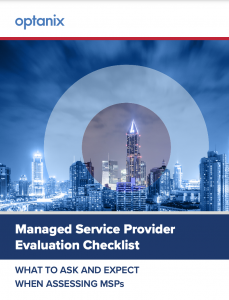
How to Future-Proof Your IT Infrastructure Strategy
Your IT Infrastructure strategy lies at the heart of the operational effectiveness and the overall conduct of your business. Thanks to digital transformation, every aspect of your interaction with your customers, employees and other stakeholders is tied to the IT infrastructure that supports your services, processes, and operations.
However, as your business needs evolve, modernizing IT infrastructure is a necessity. Failure to do so can directly contribute to a lack of profitability due to missed opportunities, or to a loss of competitiveness as the markets pull away while you struggle to catch up.
 Need insight on evaluating a managed service provider for your organization? Download this MSP Evaluation Checklist to ensure you select the best partner.
Need insight on evaluating a managed service provider for your organization? Download this MSP Evaluation Checklist to ensure you select the best partner.
Guidelines for Your Gameplan
To keep pace, you need to future proof your IT infrastructure strategy. Here are three priorities to keep in mind:
- Your first priority is to maintain continuity. Any downtime or service outage will cause a disruption to normal operations and revenue generation.
- The second is to minimize the possibility of shock – reducing the impact of unexpected consequences as a result of the transformation. As you build and execute your strategy, you need to ensure that your existing revenue streams are not affected adversely by any of the transformative exercises that come into play.
- And third, you need to ensure progress is made in the most cost-effective manner, to derive the maximum return-on-investments for the business.
Know Where You Are Coming From
So, how should you go about implementing a future-proof IT infrastructure strategy?
As you know, your IT infrastructure is a complex web of interactive elements, including networking, computing, and storage hardware, plus all of the associated software and processes that come with the estate under management.
The importance of understanding the current state of your IT infrastructure cannot be overstated. This includes best practices for maintaining a historical perspective, which will help you understand how you got here.
As you embark on your future-proofing journey, you must ensure that comprehensive documentation is maintained that describes in detail the whole picture of the infrastructure estate. This includes mapping of business processes to the infrastructure to understand the impact of any planned change to legacy systems.
Failure to do so will lead down a path of heartache and pain, resulting in the kind of disruption that leave you managing crisis instead of progress.
Know Where You Are Going
Your IT infrastructure strategy must align with the overall strategy of the business. In order to do this, it is essential to understand how business processes map onto the underlying infrastructure – and how change will impact these processes.
The strategy itself cannot be immune to change. As the strategy of the business changes, the IT transformation must adapt to match it. This involves staying in constant communications with the business stakeholders and ensuring that the IT strategy and framework are always a step or two ahead of their needs.
Here are some best-practice guidelines to consider:
- Build a realistic plan, one that is achievable and trackable.
- Organize oversight at the program level. Focusing on individual projects can be detrimental in terms of losing sight of the overall picture.
- Keep in mind that changes in one area may have adverse effects in another. Without oversight, this can lead to delays and unintended consequences.
- Effective oversight will also enable your ability to be agile – to react to the unexpected and to rapidly adapt to evolving needs.
Use Your Internal Resources Wisely
Your IT team will need to adapt to a role that goes beyond juggling trouble-tickets and maintaining operational effectiveness. From a transformational perspective, they will need to learn to focus on understanding the business processes that are enabled by the infrastructure.
Every infrastructure is unique and a result of years of legacy developments. No one is better positioned – or equipped – to build this understanding than your IT team. Effective use of the IT team allows the business to properly plot the course ahead.
Leverage Your Partnerships with Service Providers
These days, managed service providers (MSPs) are an integral part of most IT infrastructure ecosystems. They provide key services and support that supports your organization’s revenue-generating activities. In all likelihood, your IT infrastructure strategy will involve them in key initiatives, to varying degrees.
Your team is uniquely positioned to provide expertise and operational support in multiple domain areas. Leverage partnerships with MSPs to make the most of their ability to maximize your efforts.
Future Proof or Future Shock
From an IT infrastructure perspective, future proofing is all about preparing and being adaptive to support the business as it strives to meet the overall strategy. Failure to manage this will invariably lead to suboptimal outcomes, resulting in future shock instead of future proof.